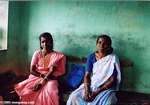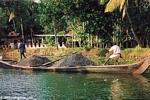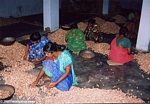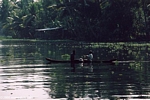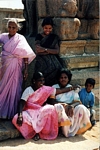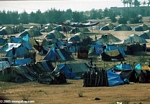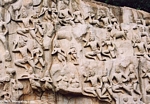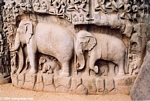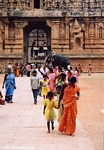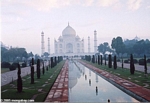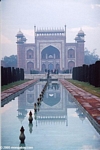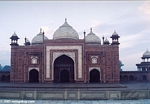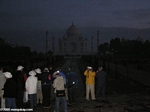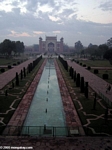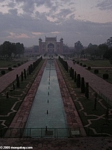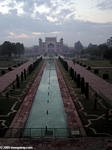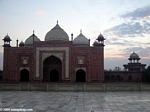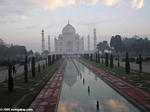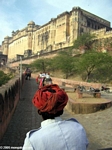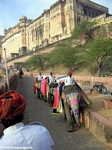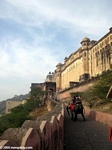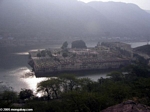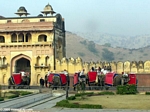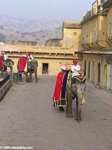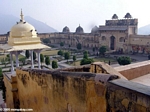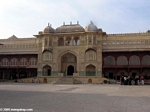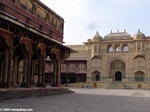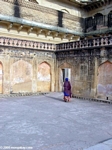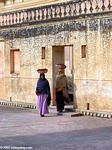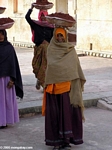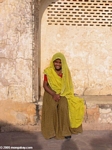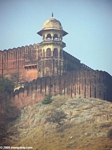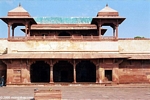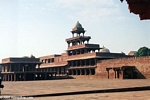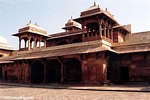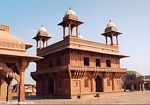Pictures of India 2005
These photographs were taken by Nancy Butler and are the property of mongabay.com, copyright 2005. Contact me with questions regarding use, reproduction, or purchase of any of the pictures.
Index | Page 2 | Palaces | Kama Sutra Carvings | Places | Other India Photos
Recommended travel guides on India:


India [Wikitravel]:
India is the largest country on the Indian Subcontinent in the south of Asia. It is geographically a large country, with significant cultural and linguistic diversity. It is a popular country among travellers.
Get in
By plane
Almost every big city in this country has an airport. Some major points-of-entry are:
- New Delhi
- Bombay (Mumbai)
- Chennai
- Hyderabad
- Bangalore
- Cochin
India has homegrown international airlines (Air India, Indian Airlines), but perhaps more convenient method of reaching India is via a non-Indian carrier like Singapore Airlines, Thai or British Airways, all of which fly into Delhi, Bombay and other locations.
Within India, the state run airline, Indian Airlines, is widely considered substandard to the privately run Jet Airways, which operates modern aircraft across much of the country. There are other private airlines as well. Tickets are generally reasonable, although far more expensive than rail travel.
By boat
India has several international ports on its peninsula.
By train
India boasts the biggest network of railway lines in the world, and the rail system is surprisingly efficient. Luxurious it is not, but India's railways are perhaps the best way to get to know the country and its people. You will get to see the beautiful Indian countryside first hand, and most train passengers will be curious about you and happy to pass the time with a chat. A few important tips regarding rail travel:
Train tickets are in high demand, especially during the summer and winter breaks. This means that without careful planning, it may be next to impossible to get tickets for long distance travel (for example from New Delhi to Bombay). However foreigners can get tickets from a quota reserved for them. In big cities, you have a specific counter or even a special office for them. If you plan to travel in 1st Class A/C (see below) tickets should be easier to get - they are in less demand. In New Delhi, you can pay your tickets in US dollars. In this case, you will pay a higher rate. For air tickets, you have to pay the "foreigner" price. Rail passes are also available, and are called Indrail passes. There is more information at https://www.indianrail.gov.in/intert.html .
The tickets could be booked online at https://www.irctc.co.in/.
Always watch your bags, especially in and around train stations. Once on a train, lock your bags to your bunk-- under the bunk if you are on the bottom, or at your head. Make sure to also lock any exterior pockets (keep your TP and anything else you'll want on the outside). While you may be tempted to travel 2nd class to save money, those cars are often overcrowded and you may not even be able to sit for more than a day at a time. Sleeper is usually your best option, ask for an "upper inside bunk" for overnight trips. 1st Class 3 A/C or 2 A/C (meaning 6 or 4 people in a compartment) is, of course even better, if you can afford it, but the A/C can be extreme. In Sleeper Class some people ignore the classes and try to get into your compartment.
Indian trains take a long time to go anywhere. Don't just look at a map and assume a short trip - these trains don't move fast. Bathrooms on Indian trains leave a lot to be desired. Shower and use the toilet elsewhere if at all possible. Bring enough food and water for the journey (including delays): Bananas, bread, and candy bars are good basics to have. At some stations hawkers selling tea or peanuts will go up and down the train, but don't count on this being enough for a 18 or 40 hour journey. On 1st Class you can order all 3 meals from the train workers. Enjoy the train! You'll meet fascinating, wonderful people.
The only international train connection is from Pakistan. See Overland Europe to South-Asia.
By car
The road network is also very well connected. There is only one pass over land from Pakistan. See Istanbul to New Delhi over land. Buses cross the border from Nepal daily, usually with connections to New Delhi, Lucknow, and Varanasi. Now there is bus service across the 'Line of control' also
Talk
Officially, India has 22 national languages (https://indiaimage.nic.in/languages.htm), namely Assamese, Bengali, Bodo, Dogri, Gujarati, Hindi, Kannada, Kashmiri, Konkani, Maithili, Malayalam, Manipuri, Marathi, Nepali, Oriya, Punjabi, Sanskrit, Santhali, Sindhi, Tamil, Telugu and Urdu. There are also other less prominent languages like Tulu, Bhojpuri the main spoken language of some places.
Hindi, spoken by 30% of the population, is the primary tongue of the people in Northern India. It is very similar to Urdu, Pakistan's national language, which uses a different script. Hindustani, a popular variant of Hindi/Urdu, is also spoken widely throughout northern India.
English is widely spoken in major cities and around most tourist places, and acts as the lingua franca among all educated Indians. But keep in mind that more than 40% of the population is illiterate. English has been spoken by Indians long enough that it has begun evolving its own rhythm, vocabulary, and inflection, much like French in Africa and Spanish in South America have taken on glittering cultural lives of their own. Indeed, much has recently been made of Subcontinental writers such as Arundhati Roy, Vikram Seth, and Salman Rushdie. The English you are likely to hear in India will be heavily influenced by British English, although spoken with the lilting stress and intonation of the speaker's other native language (Every English speaker in India is bilingual at the very least and speaks one or more of the Subcontinent's native languages). While travelers might find no difference in accent between English speakers in Delhi and Bangalore, Indians can usually tell regional English accents apart, similar to the South American ability to tell Argentinians from Colombians.
One of the most delightful quirks of Indian English is the language's adherence to Pre-1950s British English which to speakers in North America and the British Isles will sounds oddly formal. Another source of fascination and intrigue for travelers is the ubiquitous use of English for cute quips in Random places. One relatively common traffic sign reads, "Speed thrills, but kills". On the back of trucks everywhere you'll find "tata bye bye".
Indians are adopting more and more native words into their English. A lot of these are already well known to speakers elsewhere. Chai (tea), Guru (learned teacher/master), cummerbund (literally waist-tie), and avatar (reincarnation) are words that have left their original subcontinental home. However, Indians are using English loan words in their native languages at an even more rapid pace. As India modernizes blazingly fast, it has taken from English words for modern objects that simply did not exist a few decades ago. However, more importantly, bilingual Indians in informal conversation will often switch unpredictably between English and their native language when speaking to similar polyglots, thus effectively communicating in a hybridized language that relies on the listeners ability to speak both languages. A bilingual speaker in Delhi, might for example, say "mera fever bahut bad hai" (my fever is very bad) which mixes English with Hindi 50-50 in spite of the fact that perfectly good words exist for both 'fever' and 'bad' in Hindi. Such mixed phrases are easily understood by most listeners --although not always encouraged-- and are becoming increasingly common. This hybrid is sometimes referred to as 'Hinglish' (much like Chinese/Malay-influenced English in Singapore is termed 'Singlish') It seems that English and Hindi are indeed converging among the bilingual sections of society. While English, as a distinct language, is here to stay for now, it appears that it will eventually over hundreds of years be absorbed into the vast cultural fabric of the subcontinent.
Buy
The currency in India is the Indian rupee. It trades around 44 rupees to the US dollar and 52 rupees to the Euro. Take a look at the Exchange Rates Table for Indian Rupee (https://www.x-rates.com/d/INR/table.html) for other currencies.
In principle you can live in India for a couple of hundred rupees a day. At the other end of the spectrum you can sleep in fancy 5 star hotels and spend lots of money on food and shopping.
In India you are expected to negotiate the price. If not, you risk overpaying many times - which can be okay if you think "well, it's cheaper than home". Recently (2004), in most of the big cities and even smallar towns, retail chain stores are popping up - where the shopping experience is essentially identical to similar stores in the west. There also are some government run stores like the Cottage Emporium in New Delhi, and very well organized, so that you can sample wares from all across the country in air-conditioned comfort. Although you will pay a little more at these stores, you can be sure that what you are getting is not a cheap knockoff.
Also, very often you will meet a "friend" in the street offering you to visit his or his family's shop. In about 9 of 10 cases this will simply mean that you pay twice as much as when you had been in the shop without your newly found friend.
Baksheesh -- the giving of small bribes -- is a very common phenomenon. While it is a big problem in India, indulging in it can ease certain problems and clear some hurdles. Baksheesh is also the term used by beggars, who can be found throughout India, if they want money from you.
Baksheesh is as ancient a part of Middle Eastern and Asian culture as anything else. It derives from the Arabic meaning a small gift.It refers as much to charity as to bribes.
Change
Outside airports you can only change US dollars, and sometimes UK sterling pounds. In big cities, there are now ATMs where you can get rupees against your international Credit card (maximum amount is 4,000-20,000 rupees depending on the ATM). State Bank of India Bank's (SBI) ATMs usually don't accept foreign cards. It is possible to get bigger amounts by "buying" on your credit card. All the retail chain stores and most places in cities accept credit cards.
Eat
Indian Cuisine is superb, and has recently begun to take its place among the great cuisines of the world. However, it would be incorrect to classify the cuisine of the Subcontinent under one culinary banner. The varied geography of the country has evolved a rich cuisine reflected in the diversity of ingredients. Indian bread (roti, naan) is the staple in most of the wheat growing plains of Northern India, while the wetter South and East are the domain of rice farming. The rich, mughal style of cooking favored in the North is vastly different from the spicy fish curries of the coastal South. Yet there is a common base to the diverse cooking styles that coexist in the country. Like most Asian cuisines, the ingredients range from exotic (lotus roots, rose petals) to completely unfamiliar tropical offerings. And like other Asian cuisines, Indian food relies heavily on spices to flavor everything from eggs to eggplant. Owing to a large number of vegetarian Hindus, Indian cuisine has evolved an astonishingly rich menu that uses no meat or eggs. At least half the menu of every restaurant is devoted entirely to vegetarian dishes. Visiting vegetarians will discover a culinary treasure that is found nowhere else in the world.
While Indian food has a reputation for being hot -- owing to the Indian penchant for potent green chilies that will bring tears to the eyes of the uninitiated -- this is a largely incomplete description. Aromatic spices such as nutmeg, cinnamon, cardamom, and cloves are equally important as the astonishing variety of red and green chillies, and peppercorns. If you want to enjoy the local food, start slowly. Don't try everything at once. After a few weeks, you can get accustomed to spicy food. If you would like to order your dish not spicy, ask for "no chili, no black pepper and no white pepper". Most visitors are tempted to try at least some of the spicy concoctions, and most discover that the sting is worth the trouble.
Some restaurants - especially those where buses stop after hours and hours of driving - can be very dirty. In this case it might be good to check if there's another one on the opposite side of the street. Fruits that can be peeled such as apples and bananas, as well as packaged snacks are always a safe option. Do not eat grapes.
In Southern India, "Hotel" means a local restaurant serving south Indian food, mostly Thali -- a full plate of food that usually includes a kind of bread and an assortment of meat or vegetarian dishes -- and prepared meals.
Like everything in India, the English names of dishes are spelled differently in different places (sometimes in two neighboring restaurants) owing to the various ways in which Indian names can be transliterated into English. Not so different from the multiple spellings of Chinese dishes in restaurants all over the Western hemisphere.
Although you might get a big menu, most dishes are served only in specific hours. A Tandoor is an Indian clay oven. This style of cooking is common in the North and is called Tandoori cooking. A Tandoor features prominently in Mughal cuisine which was popular with the Muslim rulers of North India.
Indians like their dishes very spicy, you can even find sweet cornflakes with a spicy edge and Indian candies with a piece of chili inside.
Eating by hand
In India eating with your hand (instead of utensils like forks and spoons) is very common. There's one basic rule of etiquette to observe: Use only your right hand, as the left hand is used to clean yourself in the bathroom. Don't stick either hand into communal serving dishes: instead, use the left hand to serve yourself with utensils and then dig in. Needless to say, it's wise to wash your hands well before and after eating.
For breads for all types, the basic technique is to hold down the item with your forefinger and use your thumb to tear off pieces. The pieces can then be dipped in sauce or used to pick up bits before you stuff them in your mouth. Rice is more challenging, but the basic idea is to use four fingers to pack a little ball, which can then be dipped into curry before you pop it in your mouth.
Eating by hand is frowned on in some "classier" places. If you are provided with cutlery and nobody else around you seems to be doing it, then take the hint.
Common dishes
- Aloo Gobi - Potatoes and cauliflower in a spicy gravy.
- Gulab Jamoon - Small balls from dough in a sweet sauce.
- Kashmiri Pulao - Rice with vegetables, fruits and dried fruits. Sweet and not spicy.
- Masala Dosa - Thin rice pancake with (spicy) vegetables
- Onion Utappa - Like a pancake made out of rice with onion topping, served with spicy sauce. The dish itself is not spicy but some places add green chili to it.
- Palak Paneer - Cheese chunks in a spinach gravy. Order with plain rice or Chapatti/Roti.
Glossary
- Aloo - Potatoes.
- Chapatti - also called Roti, Indian thin bread, similar to a soft Mexican tortilla.
- Dosa- Savoury rice pancake. Many variations are available - try the enormous Masala Dosa, rolled up and filled with spicy potatoes.
- Phool Gobi - Cauliflower
- Idli - Light, bland patty made from rice dough, often served with sambar for breakfast.
- Naan - Indian bread made in a tandoori (Indian oven).
- Palak - Spinach.
- Paneer - Indian cottage cheese.
- Papad - Crispy spicy thin dough circle fried in deep oil.
- Paratha - Crispy, flaky fried flat bread
- Puri - Crispy puffed dough, looks like a ball, fried in deep oil. Can be served in different sizes. If you find "puri something" it means a few small puris stuffed with different kinds of sauce and curd.
- Roti - Indian thin bread.
- Sambar - Spicy lentil mixture, similiar to a 'soup', but more often eaten over rice or with idlis or vadas.
- Thali - Plain rice served with different sauces and vegetables usually served with chapatti, pappad or puri. most places serve this dish on an "eat as you can" basis. In the south this dish is called 'meals'. You might also find Chinese Thali.
- Uthappam - A thicker version of a dosa, often with vegetables and chillis mixed in.
- Vada - Savoury Indian donut. Often served with sambar.
Drink
Tap water is generally not safe for drinking. However, some establishments have water filters/purifiers installed, in which case the water is safe to drink. Packed drinking water ('not' mineral water) is widely available. Always check bottled water to make sure the seal hasn't been tampered with.
One of the favorite and safest beverages you can get is coconut water. You can almost always find it in any beach or other tourist destinations in the south. In summer (March to July), you can get fresh sugar cane juice in many places. And even a lot of fresh fruit juice varieties in tourist places as well as in local restaurants. Be careful as fresh juice may contain many germs besides unhygienic ice! The juice waalas do not always clean their equipment properly and do not wash the fruits either.
Everywhere you can get tea (chai) of one variety or another. Most common is the "railway tea" type: cheap (2-5 Rs.) , sweet and uniquely refreshing once you get the taste for it. It's made by brewing up tea leaves, milk, sugar and spices altogether in a pot and keeping it hot until it's all sold.
You can also get "masala tea": black tea with a blend of spices. That takes some getting used to.
Drinking alcohol can either be frowned upon or openly accepted, depending on the region and religion of the area within which you are drinking. For example, as you can imagine, Goa tends to be more free-wheeling (and has low taxes on alcohol), while southern areas like Chennai are less kind to alcohol, and may even charge excessive taxes on it. Some states such as Gujarat are legally "dry" and alcohol cannot be bought openly there.
Sleep
Choices vary wildly depending on your budget and location. Cheap travellers' hotels are numerous in big cities where you can get a room for less than Rs. 100. If your wallet allows it, you can try staying in former maharaja's residence in Udaipur or modern five-star hotels in New Delhi and Bombay. The top-end of Indian luxury rests with the Oberoi, Taj, and Welcomgroup hotel chains, who operate hotels in all the major cities and throughout Rajasthan. A number of international chains including Mariott, and Hyatt also run major 5-star hotels in most Indian metropolises.
Two important factors to keep in mind when choosing a place to stay are 1) safety, and 2) cleanliness. Malaria is alive and well in certain areas of India - one of the best ways to combat malaria is to choose lodgings with air conditioning and sealed windows. An insect-repellent spray containing DEET will also help.
Learn
Yoga, ayurvedic massage and language are the courses most often looked for by foreigners. For example, Hardwar and Rishikesh are popular places for yoga courses. Varanasi has a famous university with Hindi classes.
Work
Foreigners need a work permit to be employed in India. A work permit is granted if an application is made to the local Indian embassy along with proof of potential employment and supporting documents. There are many expatriates working in India, mostly for multinational Fortune 1000 firms. India has always had an expatriate community of reasonable size, and there are many avenues for finding employment, including popular job hunting websites like monster.com!
There are many volunteer opportunities around the country including teaching. India has a reasonable presence of foreign Christian missionaries, who for the most part form the non-local religious workers, since the other major religions of the world either grew out of India or have had a long term presence.
Unless you are a professional or want to live in a polluted city the work options are pretty slim. This is not a country to make money in unless you are very imaginative and somewhat of an entrepreneur. A living can be made in the traveler scenes by providing some kind of service such as baking Western cakes, tattooing or massage.
Stay safe
As a rule India is quite safe for foreigners. Avoid going to Kashmir unless you get properly informed about the situation there.
Unfortunately thefts are quite common in places visited by tourists, but violent thefts hardly ever occur. More likely a thief will pick your pocket or break into your room. There is little culture of muggings in India.
Westerners, particularly women, attract the attention of beggars, frauds and touts. Be prepared to say "No" forcefully and persistently. Westerners should not trust strangers offering assistance or services. Be particularly wary of frauds at tourist attractions such as the temples of Kanchipuram, where they prey on those unfamilar with local and religious customs.
Stay healthy
Going to India, you have to adapt to a new climate and a new food. Don't stress yourselves too much at the beginning of your journey to allow your body to acclimate to the country. For example, take a day of rest upon arrival, at least on your first visit. Many travellers get ill for wanting to do too much in too little time. Be careful with spicy food if it is not your daily diet.
No vaccines are required for entry to India, except for yellow fever if you are coming from an infected area such as Africa. However, hepatitis and typhoid shots are recommended, as is a booster shot for tetanus.
In some places during the monsoon, malaria is quite common. However, if you intend on staying in the major cities, and will not be venturing into areas that are known to have pockets of endemic malaria, you may do well to avoid taking Anti-malarial medication. The strong side effects (including nightmares!) of such medication are a serious consideration. If you do take Anti-malarial drugs, be aware that it may become ineffective with some resistant forms of malaria. While it is quite necessary in jungle areas near the Nepal border during the rainy season, the best protection against malaria is to avoid areas that are known to harbor populations of the virus-bearing mosquitos.
Diarrhea is common because of water not drinkable and food too spicy. Bring a standard first-aid kit, plus extra over-the-counter medicine for diarrhea and stomach upset. A rehydration kit can also be helpful. The best treatment for diarrhea is to eat boiled rice and yoghurt together 3 meals a day until you're better. Then eat some raw cloves of garlic for their anti-parasite properties. Everyone in India knows this. Avoid all fried, sweet and heavy foods.
Respect
In mosques and temples it is obligatory to take off your shoes.
Whereas Indian men can be really eager to talk to travelers, women in India often refrain from contact with western men.
Travellers should be aware of the fact that Indians generally dress conservatively and should do the same. Shorts, short skirts (knee-length or above) and sleeveless shirts are not appropriate off the beach.
Female travellers in India
India is a conservative country, and some western habits are perceived as dishonorable for a woman in this culture.
- Outside of the larger cities, it is unusual for people of the opposite sex to touch each other in public. Even couples (married or otherwise) refrain from public displays of affection. Therefore, it is advised that you do not shake hands with a person of the opposite sex unless the other person extends his/her hand first. You can always just greet somebody by bringing your palms together in front of you chest, or simply saying 'Namaste'. Both forms are equally polite and correct, if a little formal.
- The same goes for smoking. Except in major cities (and only in trendy places or in high society) women do not smoke. A woman who smokes/drinks is associated with loose moral character in much of the rest of the country's growing middle class. Smoking and drinking is also not common among older rural women in many North Indian villages and communities.
- People are fully clothed even at the beach. So, be sure to find out what the appropriate attire is for the beach you are visiting. (In some rare places like Goa, where the visitors to beach are predominantly foreigners, it is permissible to be nude on the beach).
- In some local trains, there are usually cars reserved only for women and designated as such on their front.
- In most buses (private and public) a few seats at the front of the bus are reserved for women only.
- Street parties for holidays are usually devoid of women but filled with crowds of inebriated men partying down. During festivals such as Holi, New Year's Eve, and even Christmas Eve, women (especially in large urban centers) can be subjected to groping and sexually aggressive behaviour from these crowds. It is probably unsafe for women to attend these festivities alone.
- Friendly conversation with men you meet on trains, etc. is often confused flirtation/availability. In some scenarios, this can lead to unexpected sexual advances (this happens to Indian women as well, not just Westerners. It is sometimes called "Eve Teasing"). Befriending Indian women, however, can be a wonderful experience for female travellers, though you might have to initiate conversation.
Contact
The country code for India is 91. India is then divided into city codes; see the guides for individual cities for their particular codes.
When calling long distance within India, the city code must include the leading '0', while calling outside India, omit the leading zero. For example, Bombay has the city code of 022. So to call within India , you dial 022 + number and call outside to India, you dial +91 + 22 + number.
As a traveller, you will find many long distance public phones, called STD/ISD Booths (Subscriber Trunk Dialing/International Subscriber Dialing), an Indian jargon for national and international long distance respectively, and internet kiosks everywhere nowadays.
previous
Articles involving tourism in India:
SHARE:
|
|
|



